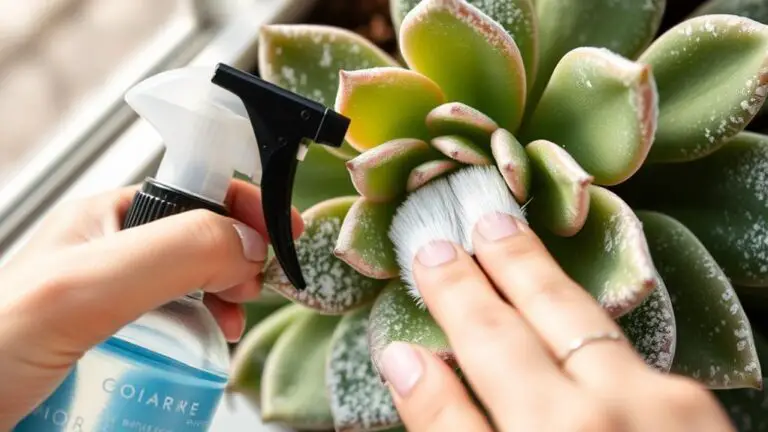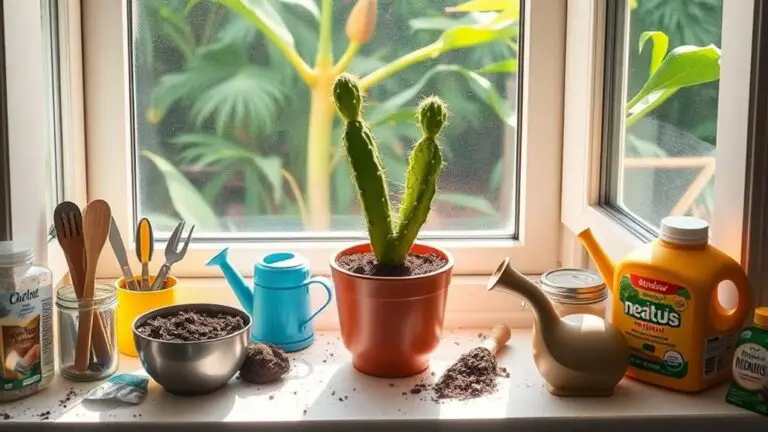10 Essential Steps for Fishbone Cactus Care
Caring for a fishbone cactus might seem straightforward, but there are essential details you shouldn't overlook. Start with understanding its light requirements—bright, indirect light is key, but too much direct sun can harm it. Next, consider its soil mix; it needs to drain well yet retain some moisture. Then, there's the watering schedule, which demands a bit more attention. You'll also want to think about where to place it in your home, as temperature and humidity levels can greatly impact its health. Let's explore each step to guarantee your fishbone cactus thrives in its new environment.
Light Requirements

When it comes to light requirements, fishbone cactus thrives in bright, indirect light, making it perfect for spots that get several hours of such light each day.
This cactus loves the gentle touch of morning sun, which you can easily find near east-facing windows. It's important to guarantee the plant doesn't get hit by harsh afternoon sun, as it can lead to leaf burn.
If your fishbone cactus isn't getting enough light, you might notice leggy growth. The stems will stretch out and appear thin, which isn't ideal. Plus, blooming could be hindered, and we all want those beautiful flowers, right?
To prevent any sudden damage, gradual acclimatization to brighter spots is key. Moving your cactus into intense sunlight too quickly can cause sunburn, indicated by reddish leaves. So, take it slow and steady.
For those sunnier spots, consider using sheer curtains. They diffuse the direct sunlight, offering the bright indirect light your cactus craves without the risk of leaf bleaching.
This way, you're creating an environment where your fishbone cactus can flourish and look its best.
Ideal Placement
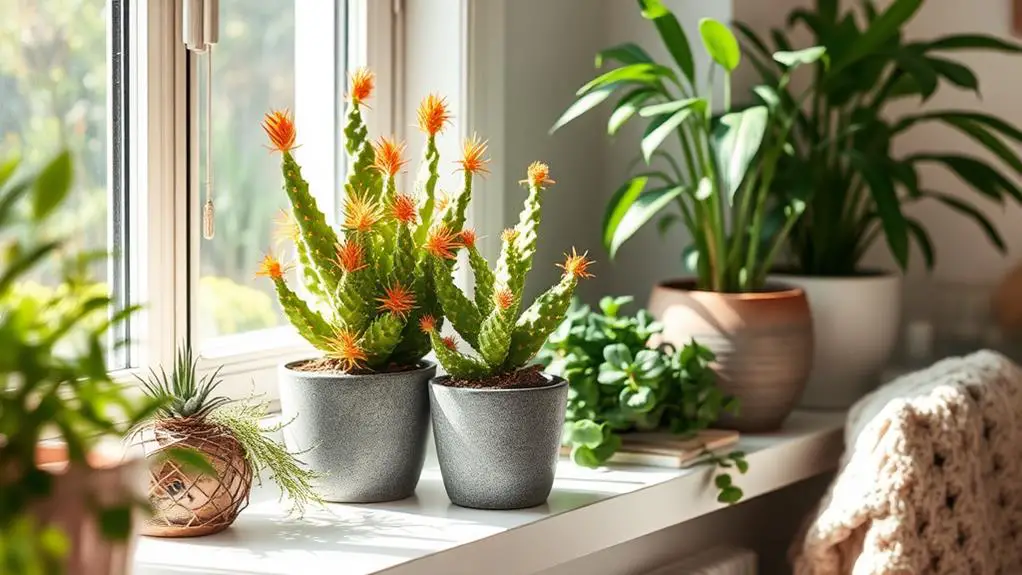
Finding the ideal placement for your fishbone cactus is vital for its overall health and growth. You'll want to guarantee it gets several hours of bright, indirect light each day. This type of lighting promotes healthy growth and blooming. Avoid direct sunlight, as it can bleach the leaves and stress your plant. For outdoor placement, aim for full morning sun with afternoon shade to prevent leaf burn from harsh sunlight during peak hours.
Indoors, choose a location that's warm and humid. Bathrooms or kitchens are excellent choices since they naturally have higher humidity levels. Securing a stable environment is essential, so keep your fishbone cactus away from cold drafts or sudden temperature changes. These conditions can negatively impact its health and slow its growth.
When deciding where to place your fishbone cactus, consider the following:
| Location | Benefits |
|---|---|
| Bathroom | High humidity, warm environment |
| Kitchen | High humidity, warm environment |
| East-facing window | Bright morning sun, indirect afternoon light |
| Living room | Warm, stable environment, indirect light |
Soil Mix
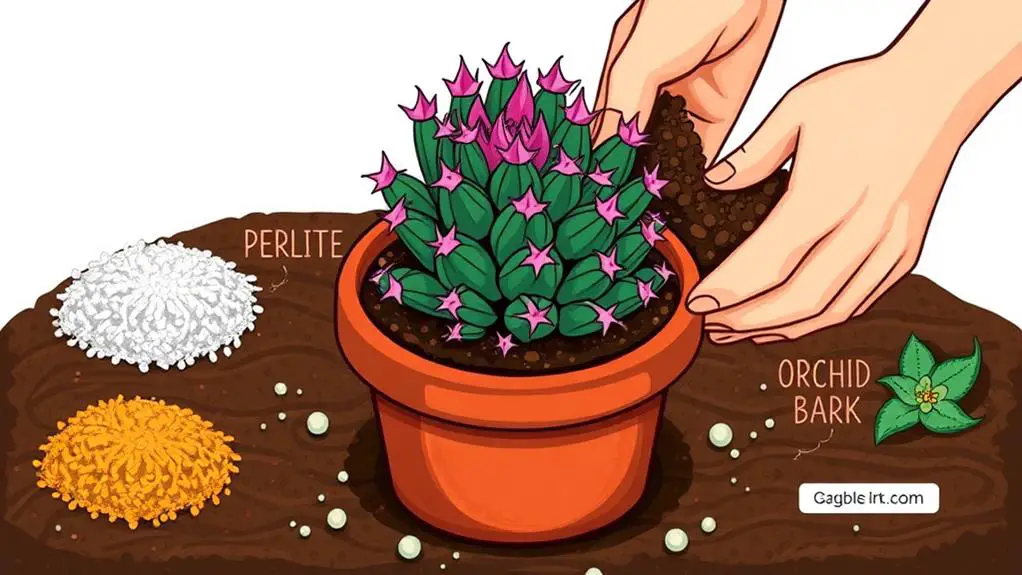
For your fishbone cactus, choosing the right soil mix is essential.
You'll want a blend of cactus soil, perlite, peat moss, and orchid bark to balance moisture retention and drainage.
This combination guarantees the roots get enough air while preventing waterlogging, helping your plant thrive.
Optimal Soil Composition
A successful fishbone cactus care routine starts with a well-chosen potting mix. For the ideal soil composition, aim for a blend that is well-drained yet retains some moisture. As an epiphytic cactus, your fishbone cactus will thrive in a mix rich in organic matter. Think of a combination that mirrors its natural habitat: a blend of organic debris in a humid environment.
Here's a recommended soil mix for your cactus:
| Ingredient | Amount | Benefit |
|---|---|---|
| Cactus soil | 1 part | Provides basic nutrients |
| Perlite | 1 part | Enhances drainage |
| Peat moss | 1 part | Retains moisture |
| Orchid bark | 1 part | Adds organic matter, aeration |
Avoid using soil types that drain too quickly, as this cactus needs some moisture retention to stay healthy. When repotting, choose a pot that's 1 to 2 inches larger than the old one and make sure it has adequate drainage holes to avoid root rot. Regularly check the soil's composition and moisture levels, adjusting the mix or your watering schedule as needed. This way, you'll prevent overwatering and keep your cactus vibrant. Following these steps will set you up for success and keep your fishbone cactus happy!
Drainage and Aeration
When it comes to drainage and aeration in your fishbone cactus's soil mix, getting it right is vital for your plant's health.
First, make certain you use a well-draining potting mix. This should include equal parts of cactus soil, perlite, peat moss, and orchid bark. This combination retains some moisture while allowing excellent soil aeration, which is essential for preventing root rot.
Next, always use a pot with drainage holes. These holes help excess water escape, so it doesn't pool at the bottom and cause severe root issues. Proper drainage is a key part of good plant care. Without it, your fishbone cactus could suffer, even with the perfect soil mix.
Remember that repotting your fishbone cactus every 3 to 4 years is also important. When repotting, move your plant to a slightly larger pot to maintain soil aeration and provide fresh nutrients. This gives your cactus room to grow and thrive.
Avoid using soil mixes that drain too quickly. Your fishbone cactus needs a balance of moisture retention and aeration for ideal growth.
With these tips, you can guarantee your plant stays healthy and happy.
Watering Schedule

Maintaining a proper watering schedule for your fishbone cactus is essential for its health and growth. You should water your fishbone cactus when the top 2-3 inches of soil are dry. This is usually every week or biweekly during the growing season, but in winter, you should reduce the frequency to every 2-3 weeks.
Always use room temperature water to avoid shocking the roots, and make sure excess water drains away fully to prevent root rot.
To check soil moisture, you can use the finger test. Just stick your finger into the soil up to the first knuckle. If it feels dry to the touch, it's time to water. Choosing a well-draining potting mix is also important. It helps maintain proper moisture levels and prevents overwatering, which can lead to root rot.
If you're using a reservoir system like easyplant, refill it once a month. Still, regularly check the soil moisture to adjust your watering schedule as needed.
Your fishbone cactus will thrive in indirect light, so place it in a bright spot but out of direct sunlight. With careful attention to watering, your fishbone cactus will flourish beautifully.
Temperature Guidelines
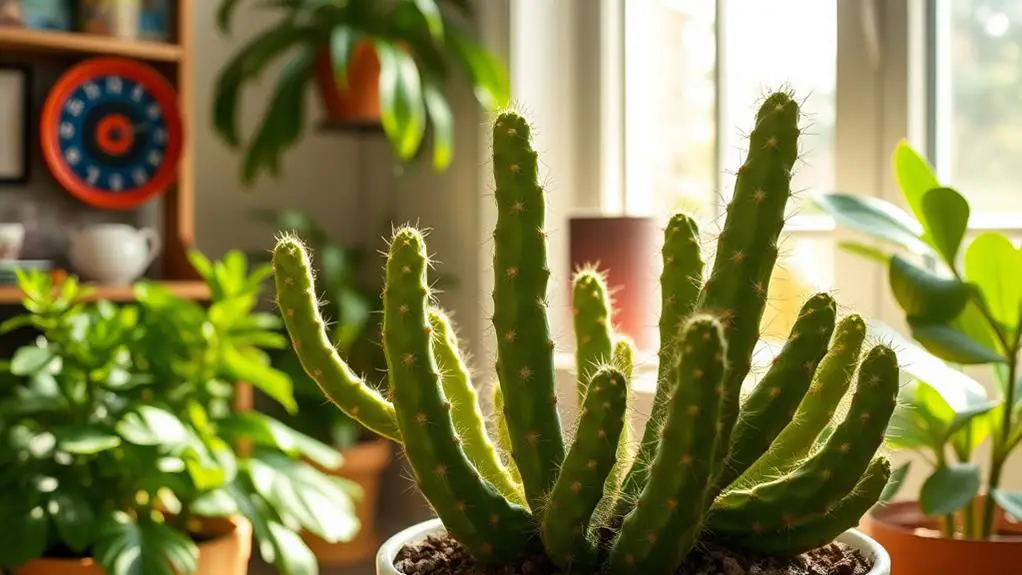
Wondering how to keep your fishbone cactus thriving? Let's talk about temperature guidelines. For ideal growth, your fishbone cactus needs temperatures ranging from 60°F to 78°F (15°C to 26°C).
It's really sensitive to cold temperatures, so be sure to bring it indoors when it gets below 40°F (4°C) to prevent frost damage.
Best spots for your fishbone cactus are warm, humid areas like your kitchen or bathroom. These places typically have stable temperatures, which are essential for your plant's well-being.
Sudden changes in temperature can stress your fishbone cactus and hinder its growth, so try to avoid moving it around too much.
When winter comes, cooler temperatures between 50°F and 60°F (10°C to 15°C) can actually encourage blooming, as long as you keep the plant dry.
This might seem a bit tricky, but with some care, your cactus will reward you with beautiful flowers.
Humidity Levels

To keep your fishbone cactus happy, make sure it gets plenty of humidity, ideally above 60%.
This is especially important if you live in a dry area, so consider placing your cactus in spots like the kitchen or bathroom where humidity is naturally higher.
You can also mist it regularly or group it with other plants to create a cozy, humid environment.
Maintain High Humidity
Achieving the proper humidity levels is essential for the well-being of your fishbone cactus. This unique plant thrives when humidity levels are above 60%, so creating a moist environment is vital for its ideal growth.
One effective way to maintain these conditions is through regular misting. By spraying your plant with water, especially if your home tends to be dry, you can help keep the humidity up.
Another great method is to use a humidity tray. Simply place a tray filled with water and pebbles beneath the pot. As the water evaporates, it increases the humidity around the plant. This can make a big difference in your fishbone cactus's health.
Selecting the right location for your cactus also helps. Kitchens and bathrooms are ideal because they naturally have higher humidity from cooking and bathing.
Additionally, grouping your fishbone cactus with other plants can create a humid microenvironment, benefiting its growth even more.
Avoid Dry Environments
Why should you avoid dry environments for your fishbone cactus? Your fishbone cactus thrives in humidity levels above 60%, so it's vital to maintain a moist environment for ideal growth.
Dry air can cause stress, making it important to keep the humidity high. A great way to guarantee proper humidity levels is by placing your cactus in areas like the kitchen or bathroom, where the air tends to be more humid.
You can also help by regularly misting your plant. This adds moisture to the air around it, mimicking the natural conditions these epiphytes enjoy in their native habitats.
Creating a humid microenvironment can also be beneficial. Grouping your fishbone cactus with other plants can collectively boost the humidity, providing a better setting for all involved.
This setup helps recreate the ambient humidity levels these plants need.
Growth Patterns

With its characteristic aerial roots and medium growth rate, the fishbone cactus exhibits fascinating growth patterns that captivate many indoor gardeners. The growth habit of the fishbone cactus is quite unique, making it a standout addition to your indoor plant collection.
The fishbone cactus thrives in indirect light and can grow noticeably during spring and summer. While it can reach lengths of 8 to 12 feet in its natural habitat, indoor growth is more manageable, making it perfect for hanging baskets or elevated pots.
You'll notice aerial roots forming along the stems, which help the plant anchor to surfaces and absorb nutrients and moisture. These roots are a normal and beneficial characteristic, so don't worry if you see them.
Providing the right amount of light is essential; insufficient light can stunt growth and cause leggy stems that stretch toward brighter sources.
Your fishbone cactus will typically reach maturity at three years, which is when it starts producing its lovely, fragrant flowers. These blooms last for about a week each cycle, adding a special touch to your plant.
Common Issues

When caring for your fishbone cactus, you might notice some common issues like root rot or pests.
Root rot shows up as brown, mushy stems and usually happens from overwatering, so make sure your soil drains well and your pots have holes.
Pests like mealybugs and fungus gnats can also cause problems, but regular checks and prompt action can keep your cactus healthy.
Identifying Root Rot
One of the most vital aspects of fishbone cactus care is promptly identifying root rot. Root rot often shows up as brown, mushy stems, a direct result of overwatering and poor drainage. To keep your fishbone cactus healthy, you need to guarantee the soil is well-draining and that the pot has adequate drainage holes. This allows excess water to escape and prevents water from stagnating around the roots.
Regularly checking the moisture level of the soil is essential. Let the top 2-3 inches of soil dry out completely before watering again. If you notice yellowing leaves or stunted growth, these could be early signs of root rot. Quick action is key to saving your plant. If you suspect root rot, repot your fishbone cactus in dry, well-draining soil and trim away any affected roots.
Here's a helpful table to visualize common symptoms and preventative measures:
| Symptom | Preventative Measure |
|---|---|
| Brown, mushy stems | Guarantee soil is well-draining |
| Yellowing leaves | Check soil moisture level regularly |
| Stunted growth | Allow top 2-3 inches of soil to dry out |
| Affected roots | Repot in dry soil, trim affected roots |
Managing Pests Effectively
How can you keep your fishbone cactus pest-free? Regularly inspect your cactus for common pests like mealybugs and spider mites. These tiny invaders can cause significant damage if not treated promptly.
Keep the plant's stems dust-free to minimize pest risk and guarantee healthy photosynthesis. A simple way to manage small mealybug infestations is to use rubbing alcohol on a cotton swab. Gently dab the affected areas to remove them without harming the plant.
Maintaining ideal care conditions is essential. Confirm proper humidity and watering to strengthen your fishbone cactus's resistance to pest problems. A stress-free environment also helps the plant stay healthy and less prone to infestations.
If pests become an issue, consider using organic pest control methods. These are safer for both your plant and the environment.
Pests and Diseases

Fishbone cacti, while generally resilient, can fall victim to a variety of pests and diseases that require vigilant care. Common pests like mealybugs, fungus gnats, and spider mites can affect your plant. Mealybugs appear as fluffy white deposits on the stems. You can treat small infestations by applying rubbing alcohol with a cotton swab. Overwatering can lead to root rot, indicated by brown, mushy stems. Verify that the soil is well-draining and monitor your watering practices to avoid this issue.
Fungal gnats thrive in overly wet conditions, so it's vital to adjust your watering schedule and improve drainage. Maintaining proper humidity, adequate light, and consistent watering will keep your fishbone cactus healthy and more resilient against pests and diseases.
Here's a quick reference table for managing these issues:
| Problem | Indicator | Solution |
|---|---|---|
| Mealybugs | Fluffy white deposits | Apply rubbing alcohol with a cotton swab |
| Root Rot | Brown, mushy stems | Verify well-draining soil, avoid overwatering |
| Fungus Gnats | Small flying insects | Adjust watering schedule, improve drainage |
| Spider Mites | Webbing on leaves | Increase humidity, use insecticidal soap |
| General Pests | Stunted growth, spots | Regular inspections and proper plant care |
Blooming Tips

To get your fishbone cactus to bloom, you'll need to provide the right conditions and care. Start by ensuring your cactus is mature, which usually takes about three years of proper care.
Here are three key blooming tips to help your Fishbone cactus thrive and flower beautifully:
- Maintain Cooler Temperatures: During winter, keep the temperature between 11-14°C (52-57°F). This cooler environment, combined with reduced watering, promotes bud formation.
- Use Potassium-Rich Fertilizer: During the growing season, use fertilizers high in potassium. This nutrient supports flower development and helps your cactus produce those lovely blooms.
- Ensure Adequate Light Exposure: Place your cactus in a spot where it gets plenty of indirect sunlight. Proper light exposure is essential for healthy growth and successful flowering.
As spring approaches and you notice budding, increase watering and feeding to support the flowering process.
The fragrant flowers of the Fishbone cactus bloom at night and last for about a week, so keep an eye out to enjoy them at their best.
With these blooming tips, you'll be well on your way to enjoying a gorgeous, flowering Fishbone cactus.
Frequently Asked Questions
How to Take Care of Fishbone Cactus?
Make certain your fishbone cactus gets bright, indirect light. Water only when the top soil dries. Maintain high humidity and warm temperatures. Use well-draining soil. Inspect for pests regularly and keep leaves clean.
How Do I Make My Fishbone Cactus Fuller?
To make your fishbone cactus fuller, give it bright, indirect light daily. Prune leggy stems, use diluted fertilizer every 6-8 weeks, maintain humidity above 60%, and water when the top soil dries. Group with other plants.
How Often Should I Water My Fishbone Cactus?
You should water your fishbone cactus every 1-2 weeks during the growing season when the top 2-3 inches of soil are dry. In winter, reduce watering to every 2-3 weeks as the plant requires less moisture.
Should I Mist Fishbone Cactus?
You should mist your fishbone cactus once or twice a week to maintain humidity, especially in dry environments. Use distilled or aged tap water and avoid over-saturating the soil. Don't mist during winter months when it's dormant.
Conclusion
Taking care of your fishbone cactus might seem tricky at first, but by following these 10 essential steps, you'll set yourself up for success. Remember to provide the right light, soil, and water. Keep an eye on temperature and humidity, and don't forget to prune and watch for pests. With a little patience and attention, your cactus will thrive. You've got this, and your fishbone cactus will thank you with beautiful growth and blooms!


